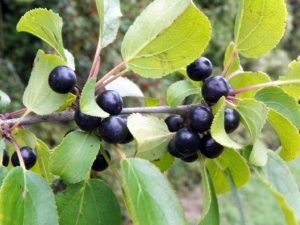The plant contains anthraquinone glycosides, acids like ascorbic acid, pectins, flavonoids, tannins, and anthocyanins. The seeds contain Glucofrangulin and frangulin, Emodin and emodinanthrone.
Contents
Uses
- Buckthorn contains an ingredient called anthraquinone that may have cancer fighting properties. Prostate.net website states that buckthorn is used orally in folk remedies to treat cancer however this use has not been substantiated by scientific evidence. Buckthorn is also used as a health tonic and was traditionally used as a “blood purifier” and diuretic.
Benefits
- The plant helps clean toxins from the body.
- It can be strongly purgative and it is therefore used in the treatment of constipation. In some cases, where a patient has had rectal surgery, this herb is given so that the patient has soft stools that do not aggravate the surgery area. Due to its bitter taste and strength, it is often used as the last resort treatment.
- Its diuretic properties help cleanse the blood.
- This herb is used for liver, gall bladder problems and intestinal problems in people.
- Home treatments for colic, obesity, dropsy and hemorrhoids, all use buckthorn.
- The herb can also be used in small quantities, in the treatment of certain skin problems like that of warts as also in relieving itching.
- The berries infusion or syrup, when had hot, can induce perspiration and help in reducing fever.
- This mixture can also treat lead poisoning, gout, rheumatism, and expel parasites.
Cautions
- This herb is usually recommended for short and small doses.
- This herb has contraindications for pregnant or breast feeding women.
- This herb is also not advised for children.
- This herb also has not external use and is rarely used in aromatherapy applications too.
- This herb is also better avoided if you have aggravated forms of intestinal diseases like appendicitis or Crohn’s disease.
- The fresh berries and bark are known to cause poisoning. The best bark that can be used is bark that is 3 to 4 years old. It is important to age the bark for a year at least. Once you have the bark, keep it in storage for a year. You can even dry the bark in the oven and then store it.
Interactions
- Unknown, please consult your pharmacist.
Other names
- Purging buckthorn, Rhamnus frangula L., Rhamnus cathartica L., Alder buckthorn, Dyer’s buckthorn, Italian buckthorn, Sanguinho, Hollyleaf buckthorn, European black alder, European buckthorn, Persian berries, Common buckthorn, Waythorn
References
Source: Home Remedies for you, http://www.home-remedies-for-you.com/herbs/buckthorn.html
LiveStrong, https://www.livestrong.com/article/409239-buckthorn-bark-health-benefits/

